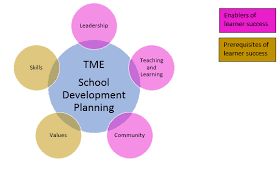School Development Planning (SDP) is a continuous process that aims at managing change and enhancing quality in educational institutions. At its core, SDP helps schools translate their vision into reality by establishing clear priorities, targets, and actionable steps. It involves a systematic analysis of the school’s current performance to identify areas for improvement over a period typically spanning one to three years.
How is the process of School Development Planning (SDP) carried out?
The process of SDP, as outlined by Hargreaves and Hopkins (1991), consists of four key stages:
Audit: This stage involves a comprehensive analysis of the school’s strengths and weaknesses, enabling the identification of specific needs.
Planning: Here, the school establishes priorities and targets, ensuring commitment among staff members.
Implementation: The leaders involved in the process put the plans into action through ongoing efforts, learning, and continuous review of the process.
Evaluation: They continuously assess the success of implementation in line with the set targets.
SDP fosters a collaborative and flexible approach, shaping a culture where policies and plans are continually developed, implemented, evaluated, and revised according to the school’s aims and the evolving needs of the community. It provides a framework for collaborative creativity, allowing each school to adapt the process to its unique requirements.
Who is involved in the planning process?
SDP is a collaborative endeavor involving all stakeholders, including school leaders, staff, students, and parents. The involvement of stake holders strengthens partnership in which they identify the institutional needs and ensure to address them effectively.
Importance of SDP to Schools
“A school without planning is like a boat without a rudder. We cannot achieve goals unless we plan ways and means of getting there.” (Bezzina, 1999:58)
SDP plays a crucial role in providing schools with a sense of direction, establishing aims and priorities, identifying areas for improvement, monitoring the effectiveness of teaching and learning processes, and evaluating success while facilitating the revision of strategies.
By implementing SDP effectively, schools can enhance their performance in all aspects and strive towards continuous improvement and excellence in education.




